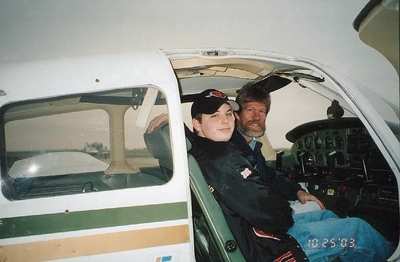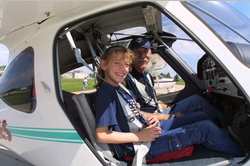More than 35,000 EAA member-pilots and 50,000 ground support
volunteers achieve remarkable goal
As we've hinted over the
last few days, an amazing milestone has been achieved as the
1,000,000th Young Eagle recently took flight. The largest youth
aviation initiative ever conceived has reached its lofty objective,
as the EAA's Young Eagles Program reached its goal of giving 1
million young people a free demonstration airplane flight by the
centennial of the Wright brothers' first flight on Dec. 17,
2003.
Andrew Grant, a 15-year-old high school sophomore
from German Valley, Ill., was registered as Young Eagle No.
1,000,000 this week, with the official announcement made by EAA
President Tom Poberezny during a news conference a short while ago
at the EAA AirVenture Museum. Grant was flown on Oct. 25, 2003, by
pilot Rick Ellis (EAA #469164) of Freeport, Ill., who has flown
more than 860 Young Eagles since 1995.
"It's difficult to put into context the true achievement of flying
one million Young Eagles," Poberezny said. "When we announced the
program in 1992, there were many people who thought flying a
million kids was simply unattainable. Through the efforts of tens
of thousands of dedicated EAA volunteers, both pilots and ground
personnel, the dream became reality. To them we say, literally,
'Thanks a million,' and celebrate this historic achievement. The
aviation community owes these people a debt of gratitude, because
they have helped secure the future of flight."

Grant and his family, along with Ellis, have been invited to
Kitty Hawk, N.C., next month to attend EAA's Countdown to Kitty
Hawk, presented by Ford Motor Company, the official ceremony
celebrating 100 years of powered flight. During the Dec. 17
festivities, Grant will fly with Gen. Chuck Yeager, the first
person to fly faster than the speed of sound and Chairman of the
Young Eagles Program since 1994. This flight will formally
recognize the 1 million Young Eagles and all the volunteer pilots
who participated in the program.
"It's really a big deal and I'm getting kind of nervous about
it," Grant said about that upcoming flight with Gen. Yeager.
Ellis has flown Young Eagles every year since obtaining his
Private Pilot's certificate eight years ago. Interestingly, his
first meaningful flight experience as a teenager was at the annual
EAA fly-in convention in the 1960s, then held at Rockford, Ill.
Ellis flew in the open-air cockpit Breezy with EAA member Carl
Unger. That airplane is currently on display at the EAA AirVenture
Museum.
"I'm sure the Wright brothers had much greater vision than what
we give them credit for, but even they couldn't realize how much
impact their achievement would have," Ellis said. "To celebrate the
100th anniversary of flight and to do it where the Wrights had the
first successful flights is going to be awesome."

The Young Eagles Program was created in 1992 after EAA members
indicated that one of the most important initiatives should be
introducing young people to aviation. The initial Young Eagles
flights took place during the 1992 EAA fly-in convention in
Oshkosh, piloted by Poberezny and Academy Award-winning actor Cliff
Robertson, who was the first Honorary Chairman of the program.
Poberezny's daughter, Lesley, was the first Young Eagle
registered.
The program has maintained its popularity in part because of its
simplicity. A pilot and each Young Eagle conduct a preflight check
of an airplane, focusing on how the airplane works and how pilots
prepare to fly safely. They then board the aircraft and take a
brief (usually 15-20 minute) flight, where young people can
discover more about the aircraft and the unique perspective from
the sky. Following the flight, each Young Eagle receives a
certificate signed by the pilot and Gen. Yeager (seen below), and
also has his or her name entered in the "World's Largest Logbook,"
which is on permanent display at the EAA AirVenture Museum and
through the www.youngeagles.org
web site.

Since those first flights in 1992, Young Eagles flights have
taken place on every continent except Antarctica and in aircraft
ranging from business jets to blimps. Each year, EAA receives
numerous reports of young people who have been inspired to pursue
aviation as a career or as recreation because of their Young Eagles
flights. Many of those early Young Eagles are now flying Young
Eagles as well. Every major university aviation program and all
U.S. military academies also have current students who were
inspired by a Young Eagles flight.
In addition, the Young Eagles Program has reached many
underprivileged young people throughout the country, such as
inner-city youth and those living on tribal reservations or in
remote areas. Young Eagles has also offered the wonder of flight to
thousands of disabled youngsters and Special Olympians over the
past 11 years.
 "As we said when we introduced the
program in 1992, the Young Eagles Program is planting seeds for the
future of aviation," Poberezny said. "Some of those seeds sprout
immediately, while others may not blossom for 10 or 20 years. This
program is vitally important because it is the base for aviation's
future. It makes a difference for aviation and especially for the
young people who are touched by it. Those of us who have
participated in it have found that we receive much more in return
than what we give to the effort."
"As we said when we introduced the
program in 1992, the Young Eagles Program is planting seeds for the
future of aviation," Poberezny said. "Some of those seeds sprout
immediately, while others may not blossom for 10 or 20 years. This
program is vitally important because it is the base for aviation's
future. It makes a difference for aviation and especially for the
young people who are touched by it. Those of us who have
participated in it have found that we receive much more in return
than what we give to the effort."
Poberezny also emphasized that the Young Eagles Program will
continue after the Dec. 17 festivities. The program has become a
major activity for EAA Chapters and at local airports. In the
future, the program will offer additional resources for young
people who are interested in discovering more about flight.
 ANN's Daily Aero-Term (04.30.24): Runway Centerline Lighting
ANN's Daily Aero-Term (04.30.24): Runway Centerline Lighting ANN's Daily Aero-Linx (04.30.24)
ANN's Daily Aero-Linx (04.30.24) Airborne 04.24.24: INTEGRAL E, Elixir USA, M700 RVSM
Airborne 04.24.24: INTEGRAL E, Elixir USA, M700 RVSM Airborne 04.29.24: EAA B-25 Rides, Textron 2024, G700 Deliveries
Airborne 04.29.24: EAA B-25 Rides, Textron 2024, G700 Deliveries Airborne-NextGen 04.23.24: UAVOS UVH 170, magni650 Engine, World eVTOL Directory
Airborne-NextGen 04.23.24: UAVOS UVH 170, magni650 Engine, World eVTOL Directory






